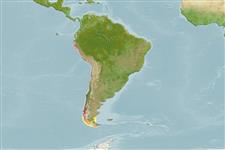Common names from other countries
Environment: milieu / climate zone / depth range / distribution range
Ecologia
; intervalo de profundidade 0 - 40 m (Ref. 87801). Temperate, preferred 12°C (Ref. 107945); 6°S - 56°S, 81°W - 66°W (Ref. 111805)
Eastern Pacific and Western Atlantic: From Lobos de Afuera Island, Peru to Cape Horn, Chile.
Length at first maturity / Tamanho / Peso / Idade
Maturity: Lm ? range ? - ? cm Max length : 15.0 cm ShL macho/indeterminado; (Ref. 356)
Life cycle and mating behavior
Maturidade | Reprodução | Desova | Ovos | Fecundidade | Larvas
Egg masses are composed of 243 to 256 egg capsules, each capsule containing 668 to 14,250 eggs. The capsules are found attached to a substrate by a stalk. Larva emerges from the egg and remains in the water column for a long period of time before settling (Ref. 87801).
Häussermann, V. and G. Försterra. 2009. (Ref. 87801)
Status na Lista Vermelha da IUCN (Ref. 130435: Version 2024-1)
Status no CITES (Ref. 108899)
Not Evaluated
Not Evaluated
Uso pelos humanos
Pescarias: espécies comerciais
FAO - Aquacultura: produção; pescarias: landings | FishSource | Sea Around Us
Ferramentas
Fontes da internet
Estimates based on models
Resiliência
Muito baixo, tempo mínimo de duplicação da população maior que 14 anos (K=0.06).
Vulnerabilidade
Low to moderate vulnerability (31 of 100).
